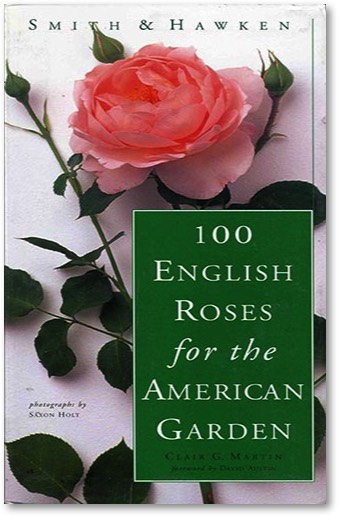
Musings » English Roses for American Gardens


New York
Workman's Press for Smith and Hawken 1997
Clair Martin is the curator of roses at the Huntington Botanical Garden and Library, a most responsible position. He inspires a band of devoted volunteers at the garden who spend several days a week deadheading and pruning the plants.
Clair has not only maintained the rose garden but
has made substantial contributions to the greater world of roses. One way is by writing books such as this one. Another is through his website, The Rosarian Network.
The organizing of roses into classes began nearly two hundred years ago and continues to generate a great deal of argument. By now most of
us are comfortable with the standard ones, such as Tea Roses, Shrub Roses and so forth, but every so often someone upsets everything by trying to designate a new class.
Depending on what is at stake it may take the leaders of rose orthodoxy anywhere up to thirty years to accept it. The hugely popular class of Hybrid Tea roses was not officially adopted from 1867 when the first one,
‘La France’, appeared until 1893. They were still lumped in with the Hybrid Perpetuals.
The class of Floribundas is another case in point. For years the purists insisted on calling them Hybrid Polyanthas. David Austin has been going through the same trials in introducing his handsome English Roses. The difficulty has been that the criteria are not crisp and easy to apply. The chief characteristic is the nature of the mature flower.
Unlike the Hybrid Teas, it is not only the bud which has to conform to the expected contour but the flower when fully open has to make its own impact. Apart from that there are no hard and fast rules.
Classification does not affect popularity directly. The public will buy the roses and enjoy them no matter what the appellation. Indirectly, classification is important to the
professional breeder. There is the personal value of acceptance and recognition by his peers. Prizes and medals definitely boost sales because advertising is enhanced.
This is where Clair’s book comes in. It is devoted to considering the Austin roses one by one, with wonderful close up photographs by Saxon Holt. Clair has grown all the varieties he mentions and gives a clear but succinct account of the strengths and weaknesses of each one.
The publisher decided to make the book very narrow, presumably to fit into a pocket. This means that although the image of each rose has a page to itself, there is no room for a picture of the bush as a whole. The rose is shown on a stem with its leaves and buds. Clair describes the bush
and its habit but a picture would make a lot of difference. Perhaps the book can be expanded if and when it is re-issued.
One very nice feature is a good explanation of how the roses were named and the derivation of any very unusual name. Austin delved into great English poetry, such as Chaucer, Shakespeare and Gerard Manley Hopkins. He honors his family and friends. Even the fictional Brother Cadfael is recognized.
If you have room in your garden for some new rose bushes, take a look at this book.

